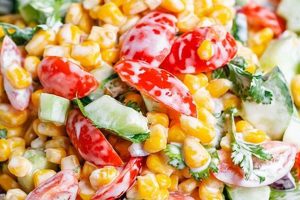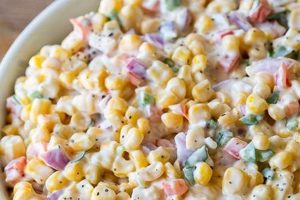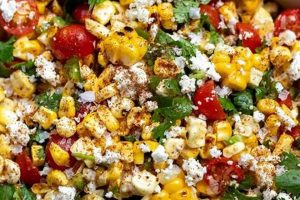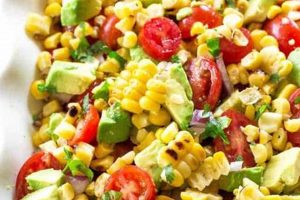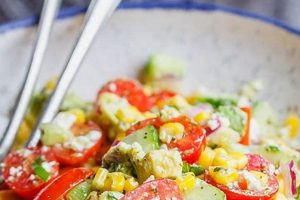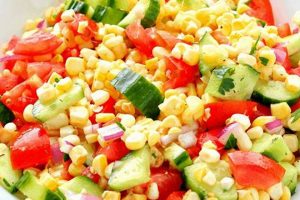Dishes featuring corn as the primary ingredient, combined with other vegetables and bound by a mayonnaise-based dressing, offer a refreshing and customizable culinary experience. These salads can range from simple combinations of corn, mayonnaise, and seasonings to more complex recipes incorporating various vegetables, herbs, and proteins. For instance, a basic version might include sweet corn kernels, chopped red onion, and a creamy dressing, while more elaborate iterations could add ingredients like bell peppers, black beans, cilantro, or even grilled chicken.
Such salads provide a versatile dish suitable for picnics, potlucks, or as a side accompaniment to grilled meats. The inherent sweetness of corn complements the richness of mayonnaise, creating a balanced flavor profile. Historically, mayonnaise-based salads gained popularity with the increased availability of commercially produced mayonnaise in the early 20th century. The accessibility of ingredients and the ease of preparation contribute to the enduring appeal of these dishes, particularly during summer months when fresh corn is abundant. These flavorful and adaptable salads can be a good source of fiber, vitamins, and antioxidants, depending on the chosen ingredients.
The following sections will delve into specific recipe variations, exploring the nuances of ingredient selection, preparation techniques, and potential nutritional benefits.
Tips for Exceptional Corn Salads with Mayonnaise
Elevating a simple corn and mayonnaise salad to a culinary delight requires attention to detail and an understanding of flavor pairings. These tips offer guidance on ingredient selection, preparation methods, and serving suggestions.
Tip 1: Corn Selection is Key: Freshly shucked sweet corn, when in season, provides the optimal flavor and texture. Frozen corn can be substituted, but ensure it’s fully thawed and drained before use. Canned corn is generally less desirable due to its softer texture.
Tip 2: Balance Sweetness and Acidity: The inherent sweetness of corn benefits from a counterpoint of acidity. Incorporating ingredients like red onion, chopped bell peppers, or a splash of lime juice enhances the flavor profile.
Tip 3: Elevate the Mayonnaise: While plain mayonnaise provides a creamy base, consider enhancing it with additional flavors. Incorporating Dijon mustard, minced garlic, fresh herbs, or a dash of hot sauce can add complexity.
Tip 4: Texture Variation Adds Interest: A variety of textures creates a more engaging culinary experience. Consider adding crunchy elements such as chopped celery, crumbled bacon, or toasted nuts.
Tip 5: Seasoning is Crucial: Proper seasoning enhances the overall flavor. Salt and freshly ground black pepper are essential, but experimenting with spices like paprika, chili powder, or cumin can add depth.
Tip 6: Chilling Enhances Flavor: Allowing the salad to chill in the refrigerator for at least 30 minutes before serving allows the flavors to meld and enhances the overall taste experience.
Tip 7: Presentation Matters: While taste is paramount, a visually appealing presentation enhances the dining experience. Serve the salad in an attractive bowl, garnished with fresh herbs or a sprinkle of paprika.
By following these guidelines, one can transform a basic corn and mayonnaise salad into a memorable dish, showcasing the versatility and deliciousness of this simple combination.
The following section will conclude with a summary of key takeaways and recipe suggestions for further exploration.
1. Fresh Corn
Fresh corn plays a pivotal role in corn salad recipes featuring mayonnaise, contributing significantly to the overall flavor, texture, and visual appeal. The natural sweetness of freshly picked corn kernels offers a vibrant flavor profile that complements the richness of the mayonnaise. This sweetness, at its peak during the summer harvest, provides a foundation upon which other flavors can build. For instance, the subtle sweetness of fresh corn allows for the successful incorporation of both savory elements like red onion and acidic components like vinegar or lime juice. The kernels’ crisp, juicy texture contrasts with the creamy mayonnaise, creating a more dynamic and enjoyable sensory experience. Attempting to replicate this flavor and texture with frozen or canned corn often results in a less vibrant and satisfying salad.
The use of fresh corn also influences the aesthetic appeal of the dish. Bright, plump kernels contribute a visual freshness that enhances the overall presentation. This visual appeal, combined with the superior flavor and texture, makes fresh corn the preferred choice for premium corn salads. The difference is particularly noticeable in simpler preparations where the corn flavor is prominent. While other ingredients can contribute to a successful dish, fresh corn often serves as the defining characteristic that elevates a simple salad to a culinary highlight. Choosing fresh corn also supports local agriculture and seasonal eating, adding another dimension of value to the dish.
Understanding the importance of fresh corn allows for informed ingredient selection and elevates the final product. While substitutes may be necessary due to availability or seasonality, recognizing the distinct contribution of fresh corn highlights its crucial role in achieving optimal flavor and texture. This awareness empowers culinary choices and encourages a deeper appreciation for the nuances of fresh, seasonal ingredients.
2. Creamy Mayonnaise
Mayonnaise serves as the foundational binding agent in corn salad recipes, contributing significantly to texture, flavor, and overall palatability. The quality and type of mayonnaise directly influence the final result, impacting both the sensory experience and the perceived freshness of the salad. Understanding the role of mayonnaise allows for informed choices regarding ingredient selection and preparation techniques.
- Emulsification and Texture:
Mayonnaise, an emulsion of oil and egg yolks, provides a creamy texture that coats the corn and other ingredients, creating a cohesive and appealing consistency. This emulsification process traps air, contributing to a light and airy texture, contrasting with the crunch of the vegetables. A stable emulsion is crucial for preventing separation and maintaining the desired consistency throughout storage and serving. The choice of oil within the mayonnaise (e.g., soybean, canola, olive) can further influence the flavor and texture.
- Flavor Profile Enhancement:
Mayonnaise contributes a rich, tangy flavor that complements the sweetness of corn. The subtle acidity of the mayonnaise, derived from vinegar or lemon juice, balances the sweetness and prevents the salad from becoming cloying. Different brands and varieties of mayonnaise exhibit varying levels of tanginess and sweetness, allowing for customization based on individual preferences. Furthermore, flavored mayonnaises, such as those infused with herbs or spices, can add further complexity and depth.
- Ingredient Binding and Cohesion:
Mayonnaise acts as an adhesive, binding the diverse ingredients within the salad, ensuring they remain evenly distributed throughout the dish. This cohesive property prevents the salad from becoming watery or separating into individual components, maintaining an appealing presentation. The viscosity of the mayonnaise contributes directly to its binding capacity, influencing how well the ingredients adhere to one another.
- Freshness and Shelf Life:
The quality of the mayonnaise impacts the overall freshness and shelf life of the salad. Using fresh, high-quality mayonnaise contributes to a brighter flavor and a more desirable texture. Conversely, using expired or improperly stored mayonnaise can negatively affect the taste, texture, and safety of the dish. Proper refrigeration and attention to expiration dates are crucial for maintaining the quality and safety of mayonnaise-based salads.
Careful selection of mayonnaise, considering its emulsification, flavor profile, binding properties, and freshness, significantly influences the overall quality and enjoyment of corn salad recipes. The interplay between these factors determines the ultimate success of the dish, highlighting the importance of mayonnaise as a key ingredient.
3. Complementary Vegetables
Complementary vegetables play a crucial role in corn salad recipes featuring mayonnaise, contributing to flavor complexity, textural contrast, and nutritional balance. These vegetables interact with the sweetness of corn and the richness of mayonnaise, creating a more dynamic and satisfying culinary experience. The selection of complementary vegetables depends on desired flavor profiles and textural preferences.
Vegetables like bell peppers (red, green, or yellow) introduce sweetness and a crisp texture, contrasting with the creamy mayonnaise. Red onion adds a sharp, pungent note that balances the sweetness of the corn, while celery contributes a refreshing crunch. Chopped cucumbers provide a cooling element and a subtle, watery crunch. The inclusion of more robust vegetables, such as chopped broccoli or blanched green beans, introduces different textures and nutritional benefits. Tomatoes, while technically a fruit, function as a vegetable in this context, adding a juicy burst of acidity and umami. These additions not only diversify the flavor profile but also contribute essential vitamins, minerals, and dietary fiber to the salad.
The interplay between corn, mayonnaise, and complementary vegetables is essential for achieving a well-balanced and flavorful salad. Careful consideration of textures, flavors, and colors ensures a visually appealing and nutritionally rich dish. Overly dominant flavors or textures can detract from the overall balance, while a thoughtful selection of complementary vegetables enhances the sensory experience and elevates the dish beyond a simple combination of ingredients. The choice of complementary vegetables allows for culinary customization and personalization, adapting the recipe to individual preferences and seasonal availability.
4. Balancing Acidity
Balancing acidity is a crucial element in successful corn salad recipes featuring mayonnaise. The inherent sweetness of corn, amplified by the richness of mayonnaise, necessitates a counterpoint to prevent the overall flavor profile from becoming cloying. Acidity provides this necessary balance, brightening the flavors and adding a refreshing complexity. This balance is achieved through the judicious inclusion of acidic ingredients, which interact with the other components to create a harmonious flavor profile. The absence of sufficient acidity can result in a flat, overly sweet salad that lacks depth and vibrancy.
Several ingredients effectively introduce acidity to corn salad recipes. Vinegar, in its various forms (white wine vinegar, apple cider vinegar, red wine vinegar), offers a sharp, clean acidity that cuts through the richness of the mayonnaise. Citrus juices, such as lemon or lime juice, contribute a brighter, more nuanced acidity, often accompanied by subtle citrus notes that complement the corn. Certain vegetables, like chopped red onion or pickled jalapeos, possess inherent acidity that contributes to the overall balance while also adding textural and flavor complexity. The choice of acidic ingredient depends on the desired flavor profile and the other components of the salad. For example, a salad featuring Southwestern flavors might benefit from the addition of lime juice and pickled jalapeos, while a more classic preparation might utilize a milder white wine vinegar.
Achieving the correct balance of acidity requires careful consideration of the other ingredients and the overall flavor profile being sought. Too much acidity can result in a sharp, unpleasant taste, while too little can leave the salad tasting overly sweet and heavy. The interplay between sweetness, richness, and acidity defines the final flavor profile. Practical experimentation, starting with small amounts of acidic ingredients and adjusting to taste, is often the most effective method for achieving the desired balance. This understanding of acidity’s role allows for greater control over the final flavor profile, enabling the creation of more nuanced and balanced corn salads. The proper balance elevates the dish, transforming it from a simple side to a flavorful centerpiece.
5. Seasoning
Seasoning plays a critical role in corn salad recipes featuring mayonnaise, elevating the dish beyond a simple combination of ingredients. The inherent sweetness of corn and the richness of mayonnaise provide a foundational flavor profile, but seasoning adds depth, complexity, and balance. Without proper seasoning, the salad can taste bland and one-dimensional, failing to reach its full culinary potential. Seasoning enhances the existing flavors, creating a more nuanced and satisfying experience.
Salt, a fundamental seasoning, enhances the sweetness of the corn and balances the richness of the mayonnaise. Freshly ground black pepper adds a subtle heat and complexity. Beyond these basics, a variety of seasonings can further enhance the flavor profile. For example, a pinch of smoked paprika adds a smoky depth, while garlic powder introduces a savory note. Chili powder or cayenne pepper can add a touch of heat, while dried herbs like dill, parsley, or chives introduce fresh, herbaceous notes. The specific seasonings chosen should complement the other ingredients in the salad. A salad featuring Southwestern flavors, for instance, might benefit from the addition of cumin and coriander, while a more classic preparation might utilize a simpler combination of salt, pepper, and dill.
The application of seasoning requires careful consideration and a nuanced approach. Over-seasoning can overwhelm the delicate flavors of the corn and mayonnaise, while under-seasoning can result in a bland and uninspired dish. Incremental addition and frequent tasting throughout the preparation process allow for adjustments and ensure a balanced flavor profile. The interaction between seasonings and the other ingredients is crucial; the seasonings should enhance, not mask, the existing flavors. Understanding the impact of different seasonings empowers culinary creativity, allowing for the development of unique and flavorful corn salad variations. This attention to seasoning transforms a simple side dish into a culinary highlight, demonstrating the power of thoughtful seasoning in elevating even basic ingredients.
6. Textural Variety
Textural variety plays a significant role in the overall enjoyment of corn salad recipes featuring mayonnaise. A combination of textures elevates the sensory experience, creating a more dynamic and engaging dish. The interplay of textures adds complexity and prevents the salad from feeling monotonous. The creamy base provided by the mayonnaise offers a foundation upon which contrasting textures can build, creating a more satisfying culinary experience.
- Corn Kernel Texture
The texture of the corn kernels themselves contributes significantly to the overall textural profile. Fresh corn offers a crisp, juicy texture that contrasts with the creamy mayonnaise. Frozen corn, while a viable alternative, often has a slightly softer texture. The choice between fresh and frozen corn, therefore, influences the final textural experience. Furthermore, the method of preparation, such as grilling or roasting the corn, can introduce additional textural nuances, adding charred or caramelized elements.
- Complementary Vegetable Textures
The inclusion of other vegetables introduces additional textural elements. Crunchy vegetables like diced bell peppers, celery, or red onion provide a sharp contrast to the creamy mayonnaise and the corn kernels. Softer vegetables, such as diced tomatoes or cucumbers, contribute a juiciness and a different type of textural contrast. The variety of textures within the complementary vegetables creates a more dynamic and interesting sensory experience.
- Textural Enhancements through Additional Ingredients
The addition of ingredients like crumbled bacon, toasted nuts, or croutons introduces further textural variation. These elements provide a crispy or crunchy contrast, enhancing the overall textural complexity. The choice of these additional ingredients should complement the other components of the salad and contribute to a balanced textural profile. For example, toasted pepitas might complement a Southwestern-inspired corn salad, while croutons could enhance a more classic preparation.
- Balancing Textures for Optimal Enjoyment
The balance of textures is crucial for achieving optimal enjoyment. An excess of any single texture, such as an overabundance of crunchy elements, can detract from the overall balance. The goal is to create a harmonious blend of textures, where each element contributes to a dynamic and engaging sensory experience. The interplay between creamy, crunchy, juicy, and crisp textures creates a more satisfying and memorable dish.
The careful consideration of textural variety transforms corn salad recipes featuring mayonnaise from simple to sophisticated. The interplay of textures creates a more engaging and satisfying culinary experience, highlighting the importance of textural balance in achieving a truly delicious and memorable dish.
7. Chilling Time
Chilling time is a crucial, yet often overlooked, element in maximizing the flavor and quality of corn salad recipes featuring mayonnaise. This period of refrigeration allows the diverse flavors of the ingredients to meld and harmonize, resulting in a more cohesive and balanced flavor profile. Furthermore, chilling enhances the textural qualities of the salad, ensuring optimal enjoyment.
- Flavor Development
Chilling allows the flavors of individual ingredients, such as the sweetness of corn, the tanginess of mayonnaise, and the sharpness of any added vegetables, to blend together. This melding of flavors creates a more complex and nuanced taste experience compared to a freshly made, unchilled salad. The chemical interactions between ingredients are enhanced at lower temperatures, contributing to the development of deeper, more integrated flavors. This is particularly noticeable with seasonings and spices, which require time to fully permeate the other ingredients.
- Texture Enhancement
Chilling firms the vegetables and allows the mayonnaise to further bind the ingredients, creating a more desirable texture. The cooling process reduces the crispness of certain vegetables, such as onions and peppers, mellowing their flavors and integrating them more seamlessly into the overall texture of the salad. This also prevents the salad from becoming watery, as the chilled temperature slows down the release of moisture from the vegetables.
- Food Safety
Chilling is essential for maintaining the safety of mayonnaise-based salads. Mayonnaise, being an emulsion of oil and egg yolks, is susceptible to bacterial growth at room temperature. Refrigeration inhibits bacterial growth, ensuring the salad remains safe for consumption. Adhering to proper food safety guidelines regarding chilling time and temperature is crucial for preventing foodborne illnesses.
- Optimal Serving Temperature
Chilling the salad to the ideal serving temperature enhances the overall sensory experience. A cold salad is more refreshing and palatable, particularly during warmer months. The chilled temperature enhances the perception of sweetness and acidity, contributing to a more balanced and enjoyable flavor profile. Serving the salad at the correct temperature maximizes the intended flavors and textures.
The benefits of chilling extend beyond mere convenience; chilling is integral to achieving optimal flavor, texture, and food safety in corn salad recipes featuring mayonnaise. This seemingly simple step significantly impacts the final result, transforming a basic mixture of ingredients into a well-balanced and enjoyable culinary creation. Incorporating adequate chilling time into the preparation process demonstrates an understanding of the nuances of flavor development and food safety, resulting in a more satisfying and safe culinary experience.
Frequently Asked Questions
This section addresses common inquiries regarding corn salad recipes that incorporate mayonnaise.
Question 1: What type of corn is best suited for these salads?
Fresh sweet corn, when in season, provides optimal flavor and texture. Frozen corn can be substituted if fresh is unavailable; however, ensure it is fully thawed and drained before use. Canned corn, while convenient, generally results in a softer texture and less vibrant flavor.
Question 2: How can one prevent the salad from becoming overly sweet?
Balancing the sweetness of corn with acidity is crucial. Incorporating ingredients like red onion, vinegar, or citrus juice (such as lemon or lime) provides a necessary counterpoint, preventing the salad from tasting cloying. A balance of sweet and acidic components contributes to a more complex and enjoyable flavor profile.
Question 3: What are effective strategies for enhancing the flavor of the mayonnaise base?
Plain mayonnaise offers a neutral canvas for customization. Incorporating ingredients such as Dijon mustard, minced garlic, fresh herbs (dill, chives, parsley), or a dash of hot sauce can add depth and complexity to the flavor profile. The choice of additions depends on the desired flavor profile and should complement the other ingredients within the salad.
Question 4: How long can the salad be safely stored in the refrigerator?
Properly stored in an airtight container, corn salad with mayonnaise typically remains safe for consumption for up to three days. However, the quality and freshness may decline over time. It is essential to observe signs of spoilage, such as off-odors or changes in texture, before consumption. Using fresh, high-quality ingredients contributes to longer shelf life.
Question 5: Can these salads be frozen?
Freezing is generally not recommended for corn salads containing mayonnaise. The freezing and thawing process can cause the mayonnaise to separate, resulting in an undesirable texture and potentially affecting the flavor. The texture of the vegetables may also be compromised upon thawing. These salads are best enjoyed fresh or within a few days of preparation.
Question 6: How can one adapt these recipes for dietary restrictions, such as vegan or gluten-free diets?
Vegan mayonnaise substitutes, readily available in most grocery stores, can be used to create a vegan-friendly version. Ensure all other ingredients align with vegan dietary restrictions. For gluten-free adaptations, focus on naturally gluten-free ingredients, such as fresh vegetables, and verify that any added seasonings or condiments are certified gluten-free. Careful selection of ingredients enables adaptation for various dietary needs.
Addressing these common inquiries provides a foundation for understanding the nuances of preparing and enjoying corn salad with mayonnaise. This knowledge empowers culinary exploration and facilitates informed decision-making regarding ingredient selection and preparation techniques.
The following section will offer a selection of recommended recipes for practical application of these concepts.
Corn Salad Recipes with Mayo
This exploration of corn salad recipes featuring mayonnaise has highlighted the crucial role of ingredient selection, preparation techniques, and flavor balancing in achieving a successful dish. From the importance of fresh, sweet corn to the nuances of mayonnaise selection and the careful integration of complementary vegetables, each component contributes to the final culinary outcome. The delicate balance of sweetness, acidity, and textural variety defines a well-executed corn salad. Furthermore, proper seasoning and adequate chilling time are essential for maximizing flavor development and ensuring food safety. Understanding these elements allows for informed culinary choices and empowers creative exploration within this versatile dish.
Corn salad recipes with mayonnaise offer a canvas for culinary expression, adaptable to individual preferences and seasonal ingredient availability. Continued exploration of flavor combinations and textural variations promises further evolution of this classic dish, ensuring its enduring presence in culinary traditions. The potential for innovation within this seemingly simple framework highlights the enduring appeal of fresh, flavorful ingredients combined with culinary expertise.

